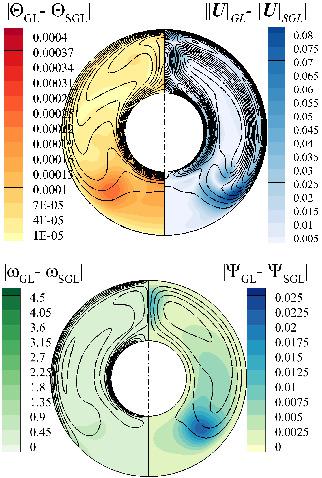当前位置:
X-MOL 学术
›
Int. J. Numer. Methods Fluids
›
论文详情
Our official English website, www.x-mol.net, welcomes your
feedback! (Note: you will need to create a separate account there.)
An efficient and simplified Gay-Lussac approach in secondary variables form for the non-Boussinesq simulation of free convection problems
International Journal for Numerical Methods in Fluids ( IF 1.7 ) Pub Date : 2021-07-14 , DOI: 10.1002/fld.5033 Peyman Mayeli 1 , Gregory J. Sheard 1
International Journal for Numerical Methods in Fluids ( IF 1.7 ) Pub Date : 2021-07-14 , DOI: 10.1002/fld.5033 Peyman Mayeli 1 , Gregory J. Sheard 1
Affiliation

|
The Gay-Lussac (GL) approach is an incompressible-based strategy for non-Boussinesq treatment of the governing equations for free convection problems that is established based on extending the density variations beyond the gravity term. Such a strategy leads to emerging the GL parameter as a non-Boussinesq prefactor of different terms in the governing equations. In this article, the GL approach is expressed/discussed in terms of the secondary variables, that is, vorticity and stream-function, for the first time and a simplified version of this approach is proposed by removing density variations from the continuity equation. The difference of results under the simplified and traditional GL approach ranges within a maximum of 1% for different parameters. The lower computational cost of numerical solution of governing equations in the secondary variables formula and the corresponding convergence rate is scrutinized for the simplified GL approach showing around 25% lower computational cost. The performance of this approach is evaluated at high relative temperature differences against the low Mach number scheme and the Boussinesq approximations. In this respect, natural convection in an annulus cavity is numerically simulated using a CVFEM solver under the aforementioned approximations up to Rayleigh number at Prandtl number and high relative temperature differences ( and 0.3). The largest deviations found for either the simplified GL or Boussinesq methods from the low Mach number scheme solution are less than 20% for velocity magnitude, 14% for stream function, 6% for vorticity, and 5% for temperature. Results under the three approximations are also analyzed in terms of the skin friction and local and average Nusselt number, indicating that the Gay-Lussac approach requires some revisions to act more accurately than the classical Boussinesq approximation at high relative temperature differences in natural convection problems, especially within the convection dominated regime.
中文翻译:

用于自由对流问题的非 Boussinesq 模拟的二级变量形式的有效且简化的 Gay-Lussac 方法
Gay-Lussac (GL) 方法是一种基于不可压缩的策略,用于对自由对流问题的控制方程进行非 Boussinesq 处理,该策略是基于将密度变化扩展到重力项之外而建立的。这种策略导致 GL 参数成为控制方程中不同项的非 Boussinesq 前置因子。在本文中,GL 方法首次根据次要变量(即涡度和流函数)进行表达/讨论,并通过从连续性方程中去除密度变化来提出该方法的简化版本。对于不同的参数,简化和传统 GL 方法下的结果差异范围在 1% 以内。次级变量公式中控制方程的数值解的较低计算成本和相应的收敛速度在简化的 GL 方法中进行了审查,显示计算成本降低了约 25%。这种方法的性能是在相对低马赫数方案和 Boussinesq 近似值的高相对温差下进行评估的。在这方面,环形腔中的自然对流使用 CVFEM 求解器在上述近似值下进行数值模拟,直至瑞利数 在普朗特数 和较高的相对温差(和 0.3)。从低马赫数方案解决方案中发现的简化 GL 或 Boussinesq 方法的最大偏差小于 20% 的速度幅度、14% 的流函数、6% 的涡度和 5% 的温度。三种近似下的结果还根据皮肤摩擦和局部和平均 Nusselt 数进行了分析,表明 Gay-Lussac 方法需要一些修改才能在自然对流问题中相对较高的温度差异下比经典的 Boussinesq 近似更准确,尤其是在对流主导的区域内。
更新日期:2021-07-14
中文翻译:

用于自由对流问题的非 Boussinesq 模拟的二级变量形式的有效且简化的 Gay-Lussac 方法
Gay-Lussac (GL) 方法是一种基于不可压缩的策略,用于对自由对流问题的控制方程进行非 Boussinesq 处理,该策略是基于将密度变化扩展到重力项之外而建立的。这种策略导致 GL 参数成为控制方程中不同项的非 Boussinesq 前置因子。在本文中,GL 方法首次根据次要变量(即涡度和流函数)进行表达/讨论,并通过从连续性方程中去除密度变化来提出该方法的简化版本。对于不同的参数,简化和传统 GL 方法下的结果差异范围在 1% 以内。次级变量公式中控制方程的数值解的较低计算成本和相应的收敛速度在简化的 GL 方法中进行了审查,显示计算成本降低了约 25%。这种方法的性能是在相对低马赫数方案和 Boussinesq 近似值的高相对温差下进行评估的。在这方面,环形腔中的自然对流使用 CVFEM 求解器在上述近似值下进行数值模拟,直至瑞利数 在普朗特数 和较高的相对温差(和 0.3)。从低马赫数方案解决方案中发现的简化 GL 或 Boussinesq 方法的最大偏差小于 20% 的速度幅度、14% 的流函数、6% 的涡度和 5% 的温度。三种近似下的结果还根据皮肤摩擦和局部和平均 Nusselt 数进行了分析,表明 Gay-Lussac 方法需要一些修改才能在自然对流问题中相对较高的温度差异下比经典的 Boussinesq 近似更准确,尤其是在对流主导的区域内。











































 京公网安备 11010802027423号
京公网安备 11010802027423号